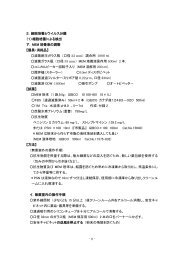Program and Abstracts(PDF)
Program and Abstracts(PDF)
Program and Abstracts(PDF)
You also want an ePaper? Increase the reach of your titles
YUMPU automatically turns print PDFs into web optimized ePapers that Google loves.
Weirich, C.R., P.S. Wills, R.M. Baptiste, P.N. Woodward <strong>and</strong> M.A. Riche. 2009. Production<br />
characteristics <strong>and</strong> body composition of Florida pompano reared to market size at two different<br />
densities in low-salinity recirculating aquaculture systems. North American Journal of<br />
Aquaculture 71:165-173. doi:10.1577/A08-016.1<br />
The effect of culture density on production characteristics <strong>and</strong> body composition of Florida<br />
pompano Trachinotus carolinus reared to market size using recirculating aquaculture systems<br />
(RASs) maintained at a salinity of 5% was evaluated in a 110-d growth trial (water temperature =<br />
27.0–28.5 o C). Juvenile Florida pompano (mean weight = 259.0 6 ± 3.0 g) were stocked into two<br />
tanks from each of four separate RASs at an initial nominal density of 6.5 (low density) or 13.0<br />
kg/m3 (high density), equivalent to 200 <strong>and</strong> 400 fish/tank, respectively. After stocking, fish were<br />
fed a 4.7-mm, floating pelleted diet (50% protein, 14% lipid) twice daily at a targeted daily feed<br />
rate of 3% body weight per day. At stocking <strong>and</strong> at 3-week intervals thereafter, 10% of the fish<br />
population of each tank was sampled to determine production characteristics, including mean<br />
weight, weight gain, specific growth rate, absolute growth rate (AGR), feed conversion efficiency<br />
(FCE), biomass, <strong>and</strong> survival. At termination, fish in all tanks were harvested to determine<br />
production characteristics <strong>and</strong> samples were obtained to determine whole-body composition,<br />
energy retention, protein efficiency ratio (PER), protein productive value (PPV), hepatosomatic<br />
index, gonadosomatic index, <strong>and</strong> fillet yield. Results indicated that final weight (570.0 g), weight<br />
gain (312.7 g), AGR (2.8 g/d), FCE (25.5%), PER (0.54), <strong>and</strong> PPV (11.5%) of fish reared at high<br />
density were significantly lower than those of fish reared at low density. No differences were<br />
observed between density treatments with respect to other measured variables. Additional studies<br />
must focus on the development of finishing diets for final stages of Florida pompano production<br />
to increase FCE <strong>and</strong> to determine optimal rearing densities. In addition, research to evaluate the<br />
potential of rearing pompano in RASs at salinities lower than 5%, perhaps through environmental<br />
or dietary enhancement of critical ions, is warranted.<br />
Riche, M. <strong>and</strong> T.N. Williams. 2010. Apparent digestible protein, energy <strong>and</strong> amino acid<br />
availability of three plant proteins in Florida pompano, Trachinotus carolinus L. in sea water <strong>and</strong><br />
low-salinity water. Aquaculture Nutrition 16:223-230. doi:10.1111/j.1365-2095.2009.00654.x<br />
Two experiments were conducted with Florida pompano, Trachinotus carolinus L. at 3 <strong>and</strong> 28 g<br />
L -1 salinity to determine apparent crude protein digestibility (ACPD), energy digestibility (AED)<br />
<strong>and</strong> amino acid availability (AAAA) from soybean meal (SBM), soy protein isolate (SPI), <strong>and</strong><br />
corn gluten meal (CGM). Mean AAAA was similar to ACPD. In fish adapted to 3 g L -1 salinity,<br />
they were 81.2 <strong>and</strong> 81.9% (CGM), 93.6 <strong>and</strong> 92.2% (SBM), 93.8 <strong>and</strong> 93.1% (SPI) for AAAA <strong>and</strong><br />
ACPD, respectively. In fish adapted to 28 g L -1 , they were 84.5 <strong>and</strong> 83.4% (CGM), 86.5 <strong>and</strong><br />
87.1% (SBM), <strong>and</strong> 83.4 <strong>and</strong> 85.0% (SPI) for AAAA <strong>and</strong> ACPD, respectively. The AED was<br />
highest for SPI <strong>and</strong> lowest for SBM <strong>and</strong> inversely related to carbohydrate. The ACPD, AED, <strong>and</strong><br />
AAAA of soy products appeared to be lower in high salinity, whereas CGM was unaffected. The<br />
data suggests SBM, SPI, <strong>and</strong> CGM should be further evaluated as partial fishmeal replacements in<br />
Florida pompano diets. Application of the generated coefficients can be used to develop wellbalanced,<br />
low-cost diets for Florida pompano reared in low salinity or seawater.<br />
Pfeiffer, T.J. <strong>and</strong> M. Riche. (In press). Evaluation of a low-head recirculating system used for<br />
rearing Florida pompano to market size. Journal of the World Aquaculture Society.<br />
40



